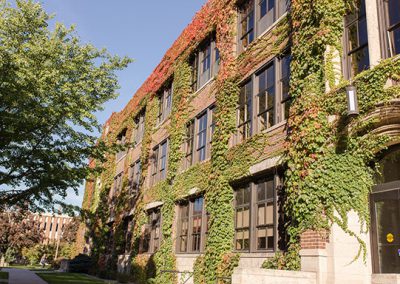Just a few weeks ago, Somsen Hall and Phelps Hall were added to the National Register of Historic Places. This means that they are at least 50 years old, kept in much the same structure and appearance, and places of historical significance.
The national recognition made me take a second look at these buildings that I enter every day. The normalcy of it made me think about how little I know about Winona State’s history, even though I’ve lived here for three years.
Tour guides give you a little bit as your group wanders across campus: “And this to your right is Phelps Hall. It is the oldest building on campus and part of the original teachers’ college established in 1858.”
Today, I would like to fill in some of the gaps (I promise it won’t be boring!).
Once upon a time, there was a—just kidding…here we go:
Minnesota became a state in May 1858 and one of the first things the newly created legislature did was establish First State Normal School of Minnesota to train teachers. It was the first normal school west of the Mississippi and classes began in 1860 but were halted for three years during the Civil War.
Phelps Hall—then called the Model School Building—was built in 1915 and housed a “laboratory program” where elementary school kids were taught by the teachers-in-training. When College Hall, otherwise known as Somsen Hall, was finished in 1924, a similar laboratory program was offered for junior high students.
When the Normal School became Winona State Teachers College in 1921, it was then able to offer bachelor’s degrees and in 1926, four students graduated with four-year teaching degrees. For the next two decades, the college continued to educate teachers and added new courses, departments, athletic teams and social organizations for the expanding student population.
After WWII, the Winona State as we know it today started to form. In 1957, the word “Teachers” was dropped from the institution’s name and associate’s and master’s degree programs were now also available. By the end of the 1970s, all the major buildings that we see on campus today were constructed to accommodate the rapidly rising student enrollment which jumped from 643 students in 1948 to 5164 students in 1981, according to an article in the Winona Post.
In 1975, Winona State College was upgraded to Winona State University. Today WSU has 80 degree programs, about 8,800 students and over 8 million student clubs and organizations (ok, I made that last one up—though we do have A LOT of clubs.) That’s quite a journey from 4 graduates in 1926 to the 794 graduates in 2012-2013.
So next time you walk to class take a moment to remember that this place has stood here long before you and will likely go on long after you’ve gone. Someday, someone will be writing another piece about WSU’s history and they will be writing about you, too.
P.S. If you are interested in reading more about WSU’s history, check out a copy of WSU: a History of 125 Years by R.A. DuFresne (LD 6091.W77 D83) from the Darryl W. Kruegar Library.
